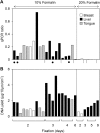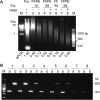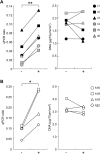Assessment of the quality of DNA from various formalin-fixed paraffin-embedded (FFPE) tissues and the use of this DNA for next-generation sequencing (NGS) with no artifactual mutation
- PMID: 28498833
- PMCID: PMC5428915
- DOI: 10.1371/journal.pone.0176280
Assessment of the quality of DNA from various formalin-fixed paraffin-embedded (FFPE) tissues and the use of this DNA for next-generation sequencing (NGS) with no artifactual mutation
Abstract
Formalin-fixed, paraffin-embedded (FFPE) tissues used for pathological diagnosis are valuable for studying cancer genomics. In particular, laser-capture microdissection of target cells determined by histopathology combined with FFPE tissue section immunohistochemistry (IHC) enables precise analysis by next-generation sequencing (NGS) of the genetic events occurring in cancer. The result is a new strategy for a pathological tool for cancer diagnosis: 'microgenomics'. To more conveniently and precisely perform microgenomics, we revealed by systematic analysis the following three details regarding FFPE DNA compared with paired frozen tissue DNA. 1) The best quality of FFPE DNA is obtained by tissue fixation with 10% neutral buffered formalin for 1 day and heat treatment of tissue lysates at 95°C for 30 minutes. 2) IHC staining of FFPE tissues decreases the quantity and quality of FFPE DNA to one-fourth, and antigen retrieval (at 120°C for 15 minutes, pH 6.0) is the major reason for this decrease. 3) FFPE DNA prepared as described herein is sufficient for NGS. For non-mutated tissue specimens, no artifactual mutation occurs during FFPE preparation, as shown by precise comparison of NGS of FFPE DNA and paired frozen tissue DNA followed by validation. These results demonstrate that even FFPE tissues used for routine clinical diagnosis can be utilized to obtain reliable NGS data if appropriate conditions of fixation and validation are applied.
Conflict of interest statement
Figures








Similar articles
-
Formalin-fixed paraffin-embedded sample conditions for deep next generation sequencing.J Surg Res. 2017 Dec;220:125-132. doi: 10.1016/j.jss.2017.06.077. Epub 2017 Jul 27. J Surg Res. 2017. PMID: 29180174 Free PMC article.
-
Next-generation sequencing of RNA and DNA isolated from paired fresh-frozen and formalin-fixed paraffin-embedded samples of human cancer and normal tissue.PLoS One. 2014 May 30;9(5):e98187. doi: 10.1371/journal.pone.0098187. eCollection 2014. PLoS One. 2014. PMID: 24878701 Free PMC article.
-
Next-Generation Sequencing Using S1 Nuclease for Poor-Quality Formalin-Fixed, Paraffin-Embedded Tumor Specimens.J Mol Diagn. 2018 Nov;20(6):802-811. doi: 10.1016/j.jmoldx.2018.06.002. Epub 2018 Jul 25. J Mol Diagn. 2018. PMID: 30055350
-
Formalin-Fixed and Paraffin-Embedded Samples for Next Generation Sequencing: Problems and Solutions.Genes (Basel). 2021 Sep 23;12(10):1472. doi: 10.3390/genes12101472. Genes (Basel). 2021. PMID: 34680867 Free PMC article. Review.
-
Systematic review and feasibility study on pre-analytical factors and genomic analyses on archival formalin-fixed paraffin-embedded breast cancer tissue.Sci Rep. 2024 Aug 6;14(1):18275. doi: 10.1038/s41598-024-69285-8. Sci Rep. 2024. PMID: 39107471 Free PMC article.
Cited by
-
Formalin-Fixed Paraffin-Embedded (FFPE) samples are not a beneficial replacement for frozen tissues in fetal membrane microbiota research.PLoS One. 2022 Mar 17;17(3):e0265441. doi: 10.1371/journal.pone.0265441. eCollection 2022. PLoS One. 2022. PMID: 35298530 Free PMC article.
-
An efficient procedure for the recovery of DNA from formalin-fixed paraffin-embedded tissue sections.Biol Methods Protoc. 2022 Jul 26;7(1):bpac014. doi: 10.1093/biomethods/bpac014. eCollection 2022. Biol Methods Protoc. 2022. PMID: 35937639 Free PMC article.
-
Feasibility of next-generation sequencing test for patients with advanced NSCLC in clinical practice.Thorac Cancer. 2021 Feb;12(4):504-511. doi: 10.1111/1759-7714.13786. Epub 2020 Dec 21. Thorac Cancer. 2021. PMID: 33350072 Free PMC article.
-
Prevalence of Tissue BRCA Gene Mutation in Ovarian, Fallopian Tube, and Primary Peritoneal Cancers: A Multi-Institutional Study.Asian Pac J Cancer Prev. 2020 Aug 1;21(8):2381-2388. doi: 10.31557/APJCP.2020.21.8.2381. Asian Pac J Cancer Prev. 2020. PMID: 32856869 Free PMC article.
-
Analysis of tumor mutational burden: correlation of five large gene panels with whole exome sequencing.Sci Rep. 2020 Jul 9;10(1):11387. doi: 10.1038/s41598-020-68394-4. Sci Rep. 2020. PMID: 32647293 Free PMC article.
References
-
- Vogelstein B, Papadopoulos N, Velculescu VE, Zhou S, Diaz LA Jr., Kinzler KW. Cancer genome landscapes. Science. 2013; 339(6127): 1546–58. PubMed Central PMCID: PMC3749880. doi: 10.1126/science.1235122 - DOI - PMC - PubMed
-
- Garraway LA, Lander ES. Lessons from the cancer genome. Cell. 2013; 153(1): 17–37. doi: 10.1016/j.cell.2013.03.002 - DOI - PubMed
-
- Do H, Dobrovic A. Sequence artifacts in DNA from formalin-fixed tissues: causes and strategies for minimization. Clin Chem. 2015; 61(1): 64–71. doi: 10.1373/clinchem.2014.223040 - DOI - PubMed
-
- Nakayama Y, Yamaguchi H, Einaga N, Esumi M. Pitfalls of DNA Quantification Using DNA-Binding Fluorescent Dyes and Suggested Solutions. PLoS One. 2016; 11(3): e0150528 PubMed Central PMCID: PMC4777359. doi: 10.1371/journal.pone.0150528 - DOI - PMC - PubMed
-
- Wong SQ, Li J, Tan AY, Vedururu R, Pang JM, Do H, et al. Sequence artefacts in a prospective series of formalin-fixed tumours tested for mutations in hotspot regions by massively parallel sequencing. BMC Med Genomics. 2014; 7: 23 PubMed Central PMCID: PMC4032349. doi: 10.1186/1755-8794-7-23 - DOI - PMC - PubMed
MeSH terms
Substances
LinkOut - more resources
Full Text Sources
Other Literature Sources
Miscellaneous

